#historical cosmetics
Explore tagged Tumblr posts
Text

GALLIPOT PROJECT SHOP UPDATE 5/22
I've been doing sneaky shop updates for a week or two now but it's finally time to post about them! I've got a bunch of new historically-inspired stuff live on my BigCartel shop -- you can use the code SOLSTICE for 20% off your whole order from now through 6/21.


1840s-Inspired Shaving Soap
A nice puck of tallow shaving soap for use with a shaving brush or your regular-degular hands. Enriched with a shitload of other oils and lightly scented with Atlas cedar, frankincense, and patchouli. I've got an upcoming post about shaving and 1840s shaving soaps so stay tuned!
Carnivale Lip Tints
Three buildable shade options for the girlies (gn) formulated with mango butter, beeswax, and sweet almond oil. All three of these use historically-attested ~*~*lip rouge~*~*~ pigments, incorporating carmine; if there's any interest in vegan versions of these using period vegetable waxes/pigments, let me know!
Shades, top to bottom: Graham Gore Red; Royal Marine Red; Platypus Pond Pink




Historically-Inspired Perfume Oils
Sold in 5ml amber glass apothecary vials -- these are 1840s-inspired but otherwise completely modern because they won't let me distill any floral waters in my one-bedroom apartment. All citrus-based oils used in these blends are FC-free.
Francis Crozier - Ambergris, musk, rosemary, spike lavender, lemon, orange, and petitgrain
James Fitzjames - Oakmoss, patchouli, Bulgarian rose, jasmine, neroli, and bergamot.
Hydesville Ghost - Atlas cedar, Bulgarian rose, rosemary, benzoin, myrrh.
Huile de Florida - Neroli, bergamot, lemon, rosemary, clove, rose geranium, bitter orange, and cardamom.
I had a ton of fun making these and I look forward to sharing them! These have been in the works since earlier this year and I'm hyped to get them out to people.
Some general updates: I've retired the Gallipot Project Etsy store because, whew, no kidding, Etsy's policies are bad bad. My first run of white Windsor soaps didn't turn out exactly how I'd like it to, but the second batch should be live and available before long. I'm also investigating other mid-19th-century soap formulations and their accompanying scents. Follow my projects and historical cosmetics and hygiene meta at my #unnamed terror fandom beauty project tag!
64 notes
·
View notes
Text



Ads for „Tatras’ Snow” face cream, produced by Falkiewicz company. Wacław Falkiewicz established his company in Paris in 1911, after WWI moved the production to Poznań.
15 notes
·
View notes
Text

I watched a great video where makeup historian Erin Parsons debunked Queen Elizabeths white face paint myth

but the most interesting bit to me was where she used actual ingredients to recreate historic makeup recipes

and I loved to see how sheer the finished product was. They described it as sheer like zinc sunscreen and brightening and blurring. and it just reminded me of my favorite mineral sunscreen
#historical cosmetics#historical makeup#leas face paint#queen elizabeth i of england#queen elizabeth makeup#erin parsons#personal#blog#diary post
0 notes
Text
youtube
0 notes
Text
Actually, that brand is Little Bits on Etsy! That shop has so many cosmetics/skincare/hair care stuff, and it's all based on historical recipes!! I love their stuff so much!!
Here's the link:
https://www.etsy.com/shop/LitttleBits?ref=usf_2020
We are so unnecessarily harsh to historical people and their trends. “ew why did people want their hair gray why would you put powder on your head” shut up YOU DO put powder on your head it’s called dry shampoo. It’s the exact same thing it just has a different name now. It also came in lots of different colors back besides white, sometimes you could even get it in pink but no one remembers that. And young people are still dyeing their hair gray for fashion. The only difference is we need less powder now because we wash our hair more so the trend is shiny hair and back then it was matte.
In three hundred years kids will be making fun of you too. You are not immune to fashion trends
3K notes
·
View notes
Text
[China Makeup history]The production of concealer powder for women in the Northern Wei Dynasty(386–535)of China 1,500 years ago
The author's experience of the production process is as follows:
1.Concealer powder for women in the Northern Wei Dynasty. After experiencing the entire production process, my first impression: the rice soaked for more than 20 days is really smelly! like the biological weapon my painful expression doesn't require any acting skills, but the rice soaked for many days is very soft and sticky, and it is very convenient to rub or grind it by hand (Women with no strength like me can quickly grind it into pulp in 5 minutes)
2.The process is complicated and the production takes more than 30 days. The resulting "rice powder" is indeed delicate. Although its adhesion cannot compare with today's cosmetics, it is still very good as a basic makeup powder for women more than a thousand years ago.
————————
🧚🏻Production & Model/Makeup:@曾嚼子
🔗 Xiaohongshu:http://xhslink.com/uc8W4S
————————
#chinese hanfu#Northern Wei Dynasty(386–535)#China Makeup history#hanfu#hanfu accessories#chinese traditional clothing#hanfu_challenge#china#chinese#cosmetics#historical makeup#historical fashion#曾嚼子#Concealer powder#漢服#汉服#中華風
219 notes
·
View notes
Text

i started playing sky today!!! i really really like it so far :3 i LOVE that we’re faceless!!
#scribbles#sky children of the light#sky cotl#sky children fanart#the game itself is just GORGEOUS#i can’t wait to explore and unlock more stuff + cosmetics!!!#i’m historically really bad at video games so we’ll see how this goes#but some doodles just felt right :3#and again cannot emphasize how overjoyed i am that we’re faceless it’s SO GOOD
199 notes
·
View notes
Text
the argument from corset defenders that they're just trying to say corsets "weren't universal torture devices" and/or "people didn't typically tightlace" is rendered automatically null by the fact that this is fundamentally a straw man argument - one that is made more so because they're purposefully ignoring valid critiques of corsetry - ones that actually take historical context into consideration (i.e. the role of the patriarchy, white women's bodies as tools of colonialism, fashion interlinked with industrialization and capitalism, real women's testimonies and feelings towards it, dress reform and medical history) when discussing clothing and fashion history - to repeat this rhetoric.
most critiques I've seen have encompassed discussions of gender, labour, and colonial history. It's a shame that people keep insisting on seeing the corset as (at best) a neutral item and devoid of social/racial/gendered context, and rather than as something that directly interacts with those topics, and therefore cannot be simply rendered as neutral item of clothing.
#it's also rendered automatically null by saying 'actual clothing historians'#which is mostly a self-moniker title... but that's a conversation people on here can't handle#bad history takes#name an actual historian for $100 - not a costuber or a person with a degree in art history ffs#so tired of this particular blogger being like i'm just being nuanced while presenting some of the worst takes i've seen#or that are 1/5 sort of correct and the rest absolutely does not make sense if you have any understanding of history or historical research#i remember them saying during the bridgeton corset scandal 'wow why don't these people critiquing corsets care about actresses wearing span#even though the critiques including shapewear because most people understand diet culture/shapewear as the transformation of the corset#to the foucauldian “mindful” body in which we self-regulate to create the 'ideal' body through dieting and cosmetic surgery etc.#absolutely braindead take as always#bullshit ideologies#sorry i'm in a bitchy mood today but i'm sick and tired of seeing this take and pretending it's novel or saying anything interesting#i'm so tired hearing about corsets - women undoubtedly in the 19th century and me in the 21st century
11 notes
·
View notes
Text
Experiments In Early Victorian Skincare: Bone Marrow Hair Oil
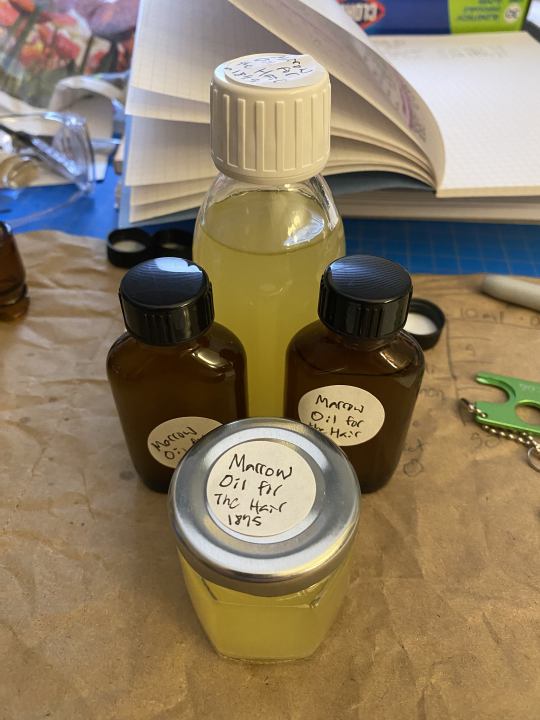
(You can find previous posts on this topic here -- next up we've got some white salves.)
Okay, ngl, this is the part of my self-imposed mission that I have been considering with the most trepidation. Not because marrow oil is objectively, in some way, less clean or more gross than the other rendered animal fats used in hair and skincare products of the era -- I found the process of buying and preparing to handle these marrow bones to be surprisingly unsettling. Not anything about the purchasing process or sourcing beef bones, either, which was as normal and cordial as any other specialty meat purchase I might make -- all I can chalk it up to is looking at the bones themselves and being acutely aware that… hey… crack open my own femur and you'd find marrow there too. [CW for a lot of animal meat, bone, and fat to follow if you're squeamish or prefer to avoid it.]
Marrow holds a horror for me that I find hard to understand in any other terms than the knowledge that I, too, am made of meat -- fittingly given The Terror's themes of subsistence cannibalism, arbitrary European squeamishness, and the smudgy line between human and animal. (In the butcher's shop, one of my friends saw my squeamishness and leaned over to whisper "just pretend you're in The Terror!", so that's where my brand is at right now. She didn't even know about this whole project, just that I'm a ghoul.)
To get the marrow out of these bones, I effectively made the most gross, boring bone broth imaginable -- I pressure cooked the frozen marrow bones (maybe eight-inch lengths of some long cattle bone, around two and a half pounds) in six cups of water for four hours and let the pressure release naturally. When I opened up my Instant Pot, all the remaining shreds of flesh had cooked off of the bones and it was already looking rich and oily The smell of boiled bones isn't gross or repulsive in any way, but it doesn't smell exactly good either, and I made it worse by immediately splashing myself with still piping-hot boiled bone water. The first thing I realized after cussing and tending to the burn was that the remaining liquid was seriously fatty -- the few places it had splashed besides my bare hand were already congealing with milky-colored oil -- and that the cooked marrow slid out of the cylinder of bone all in one piece, no prodding necessary. The bones looked… about like I'd expect boiled beef bones to look, after growing up in a household full of big carnivorous dogs who liked to chew on bones and antlers and stuff, but the inside structures were surprisingly delicate and lacy.
I let the vile bone water cool and thanked my lucky fucking stars I wasn't having to eat plain bone water. My plan was to let the """""broth""""" cool in the refrigerator and then skim the fat from the top, discard any lingering meaty solids and liquid runoff, then melt and filter the rendered fat.
I poured it into a casserole dish to maximize the surface area and promised myself I would wait. I did not wait. I waited like, 4 hours, then broke the cooled layer of fat on top like a pane of ice, picked it off with a spatula, melted it down, and poured the resulting slurry of rendered fat and lingering meat debris into a jar. Including the slurry of meat debris, which rapidly sank to the bottom.
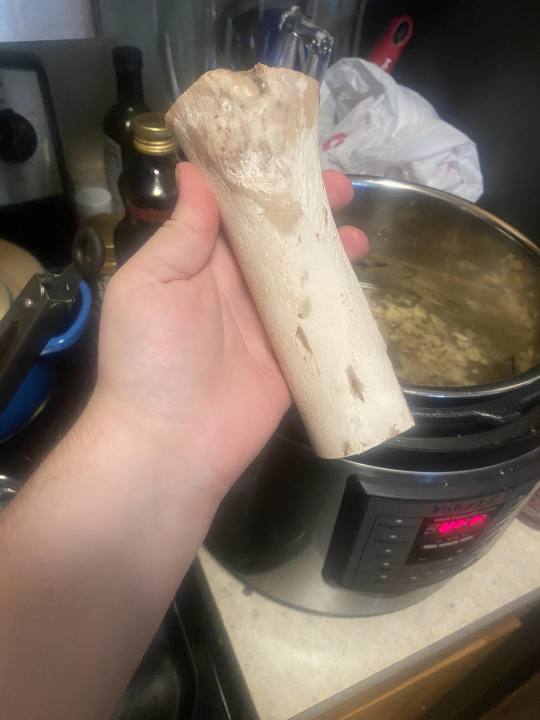
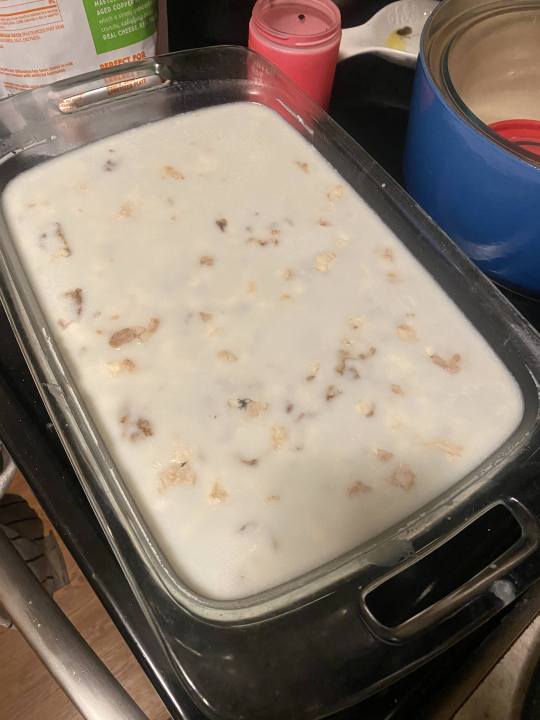
The oil… honestly was much less gross than the bone water had been. It's a nice rich yellow color when liquid and relatively odorless; what smell there was felt weirdly comforting, and then I realized I associate the smell of simmered bones and breaking-down collagen with Amish-style pot pie. (Not incidentally, also a dish that through long-term simmering transforms left-over bones and any lingering shreds of meat on them into a rich fatty broth.) It's hard to imagine a Victorian housewife or thrifty cook balking at any part of this. If I'd been born in 1815, this whole process would have been second nature to me, not a harrowing meat ordeal but a part of the practice of domestic economy. Kind of cool stuff.

I re-heated the oil in a water bath, filtered it through a coffee filter because I can't find my fucking cheesecloth and wasn't super relishing the thought of reusing fatty cheesecloth-- this may have been my undoing because it required several layers' worth of coffee filtering to keep the weight of the hot oil from just blasting through the seams. I was able to extract around four ounces of liquid fat, nearly halved, but a more efficient filter setup could have saved a good chunk of that. My hands got good and lubed up during the process and I really felt a kinship with Ishmael in his A Squeeze Of The Hand rhapsodies, as well as a genuine horror of how much cleanup this was going to take. Straight, I'd say this stuff is uncomfortably rich, and I don't know how easily it'd be absorbed into the skin.

(from Beasley's General Receipt-Book)
What to do with around four ounces of clarified beef marrow? I ended up going wit Beasley's recipe for marrow oil instead of the promised fluide de Java, not wanting to tinker with melting down wax, but not having a frame of reference for "the desired consistence" threw up a hurdle -- seeing it alongside hair oils it seemed reasonable to wager we're going for a consistency slightly more substantial than almond or olive oil alone. but still liquid at room temperature. (Liquid at polar temperatures, harder to say.) I went with a 1:1 ratio of clarified marrow to sweet almond oil, scented with clove bud, cedar, and sweet orange -- I had to go back to up the amount of fragrance after realizing quite how aromatic the marrow still was. (If I had my druthers, I love the smell of clove, but among essential oils it's particularly touchy due to its eugenol content so I kept things below the IFRA threshold for dermal use. If you make any kind of fragranced product, from apparel to solid perfume to baby wipes, you should check out IFRA's standards.
Some of the recipes I see in other texts suggest that the yellowness of marrow-based hair oils is a distinguishing quality, which might explain the use of olive oil in Beasley's fluide de Java recipe; at room temperature the mix has a pale yellow, cloudy consistency while remaining freely liquid. Frankly it still smells uncomfortably beefy. Later writer Arnold J. Cooley could have given me a better sense of the ratio of marrow to almond oil for a marrow-oil hair treatment -- he recommends 3 parts marrow oil to 8 parts almond.

If you're interested in somebody absolutely spilling the tea on the state of the Victorian hair oil retail market, his chapter on it is a treat. In particular he has a low opinion of fluide de Java:
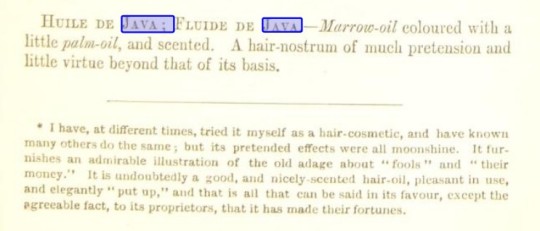
If I were making this over again I'd probably hew to the Cooley measurements, the better to stretch the amount of marrow, and up the fragrance even further -- but I'm already dreading using this stuff on my hair.
32 notes
·
View notes
Text

Always make sure your lips are drenched in lip gloss before you kiss your boy / girl to mark your territory!😘
💋💋💋
#history#lip gloss#max factor sr#hollywood#x rated#makeup history#1930s#1970s#united states#immigrants#lip smackers#womens history#historical figures#coquette#just girly things#bratz#dolletecore#black and white movies#barbiecore#american history#soft girl#flavored lips#girly girl#cosmetics#beauty#1930s hollywood#movie history#nickys facts
13 notes
·
View notes
Text
1 note
·
View note
Text

Japan: Advertising poster for Shiseido Cosmetics, Ginza, Tokyo, Maeda Mitsugu, 1927
Japan: Advertising poster for Shiseido Cosmetics, Ginza, Tokyo, Maeda Mitsugu, 1927. (Photo by: Pictures from History/Universal Images Group via Getty Images)
#1920s#1920s aesthetic#1920s beauty#beauty#cosmetics#advertising#1920s cosmetics#1920s advertising#1920s art#1920s fashion#retro#vintage#art#vintage art#Vintage#vintage ad#vintage photography#history#historical art#20s#twenties
18 notes
·
View notes
Text
SOAP MINI-UPDATE:
I'm going to go check on the version 2.0 lavender wash balls.
Will they have undergone a metamorphosis?
Or will they have succumbed to t̶͔̤̪͔̊̐̓͜ẖ̷̒̉̓̎̽̊e̸̪͈͎̓̒̚ ̸̬̖̹̥͜͝b̴̨̡͈͂͛͑̽̓͊ŗ̸̬̹̯̳̠́̏̚ò̸̡̼̼̟͎̑͌͑̑͘w̶̘͕̒͋͝��͇n̶̹̟͊̉̓̄̓̕ ̴̧̮̘̼̖̳͐̃̚͝ḧ̸͇̩̹̣͖́o̶̖̳̭͔̐́̉ŗ̵̲̉͋̾̄͂͌r̵̨̛̳͚͓̮̐̇̆̉̚ô̴̯̟̹͇̾͒͝͝r̸͓̩̳̉̑͒̒̉̒ ?
I am filled with a terrible foreboding.
#lavender soap#our flag means death#ofmd#history#stede bonnet#and his historically possible cosmetic collection#lotta ridiculous research#experimental archaeology#stede bonnet's theoretical library#stede bonnet's theoretical self-care extravagances#the historically inaccurate shop#trifles the amateur history enthusiast strikes again#funky little alchemist with funky little interests
70 notes
·
View notes
Text
Khushi Doshi
Kajal: The Future of Eyes and Beyond (Year 2104)
Eighty years from now, I am no longer just a humble stroke of black lining the eyes of millions. Once a symbol of beauty, mystery, and protection, I have evolved into something far greater. I am now a force—a blend of tradition and cutting-edge science that not only enhances but heals. I have the power to conceal, to repair, to transform.
No longer contained in tiny, ornate jars or sticks, I am housed in sleek, futuristic cartridges made from biodegradable smart materials that recognize your unique skin needs the moment you touch me. With a light swipe, I analyze your skin’s texture, temperature, and underlying imperfections. I am not just here to enhance your gaze, but to erase the marks of the past—the scars, the blemishes, the signs of a life lived in all its complexities.
Once applied, I do more than line your eyes with the deepest shades of black, sapphire, or emerald. My nano-pigments begin their work beneath the surface, gently stimulating cellular regeneration. That scar you’ve carried for years? It starts to fade, gradually erased not by a scalpel, but by the very kajal that once only served to adorn.
I adapt to you. You might have used me to intensify your beauty, but now, I am your skin’s secret keeper. I know where to conceal and where to highlight. Need a protective layer against the harsh UV rays? I create an invisible shield. Want a touch of shimmer for the evening? I deliver that too, effortlessly adjusting to the setting around you, from soft matte for the day to a radiant glow for the night.
I am infused with micro-botanical extracts that calm, hydrate, and nurture the skin, working in harmony with the latest biotech. As you glide me on, I sense your emotions, adapting not just to your skin but to your soul. A tough day? My pigments deepen, creating a bold, confident look. A light-hearted evening? I soften, adding a gentle shimmer that catches the light just so.
But I am more than appearance. My power lies in the subtle healing I offer. I treat wounds beneath the skin, fading both the physical and emotional scars that time has left behind. My ancient lineage, once tied to protection against the evil eye, has merged with futuristic technology that protects you from the world’s modern threats—pollution, stress, and aging.
You no longer apply me in front of a mirror but in front of a holographic display that shows you not only your face but your journey. As you line your eyes, you watch the scars vanish, your skin glow, and your expression sharpen with a confidence only I can bring. I am the future of kajal, born from centuries of tradition but crafted for the digital age.
I am beauty and healing, concealment and revelation. I carry with me the wisdom of the past and the innovations of tomorrow. I am kajal, but now, I am so much more.
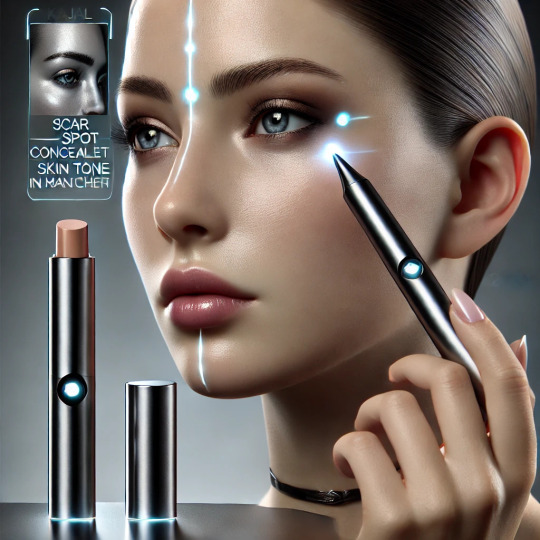
Thankyou
#futurebeauty#techbeauty#futuristicmakeup#smartbeauty#innovation#technology#AI#AR#VR#sustainablebeauty#ecofriendlybeauty#Cultural and Historical Tags:#ancientbeauty#traditionalbeauty#culturalbeauty#heritage#tradition#selfcare#skincare#wellness#lifestyle#inspiration#kajal#makeup#beauty#cosmetics#beautyblog#makeupblog#beautytips#makeuptip
2 notes
·
View notes
Text

It has been over a week since the beef marrow hair oil from @titleleaf arrived (Gallipot Project store link), and finally I had the opportunity to try it this past weekend. I use product in my hair during the work week, and being in my working class villain era it's usually combed away from my face and tucked under a knit hat. I wanted to try the hair oil on my clean, dry hair; and not on a day when it would be immediately smothered by a hat.
I was excited to try this product because the composition is similar to the "Recipe for the Hair" made with beef marrow in the 1830 book The Whole Art of Dress! This was also the book I consulted for instructions on how to use hair oil:
The way to apply oils or grease of any kind to nourish the hair, is to rub it well in at the roots, when its essential virtue can only be of service, and then brush it well. Brushing is as absolutely required by the hair, as washing by the face, it is this that bestows that fine gloss which so much improves the appearance of the hair, at the same time excluding all dandriff [sic]. This ever forms and renders the hair of a dead and unanimated appearance, when not well brushed. A hard penetrating, and a soft brush should be alternately used. The former strengthens the roots of the hair by impelling a brisker circulation of the blood, while the latter bestows the shine or polish.
For my brushes I used a paddle hair brush with plastic bristles (hard), and a military hair brush with natural boar bristles (soft). This is what my hair looks like unoiled:

And after the hair oil!


I probably applied too much of it, although that's debatable considering the historical fashion I'm emulating.

Seated Young Man with Arm Resting on Table, 1840s. Met Collection.
One of the things I loved the most about this product was the scent of clove oil. I went about my day running errands accompanied by a delicious but not overpowering fragrance. Perhaps it liquefied more with warmth, because after several hours it seemed like I had applied it with a heavier hand—although still within the bounds of early Victorian hairstyles, and if anything not as greased-up as some pictures I have seen.
It DOES have styling properties and will hold the hair in place, although not quite with the fixative power of 21st century hair gel. Next time I will try rubbing it in more, and using my hands more than the included dropper. But I'm a fan! It's a rich styling product that should last me for a while, thank you @titleleaf for your Victorian cosmetics!
#1840s#hairstyles#victorian cosmetics#gallipot project#hair oil#victorian#historical hairstyles#i need those grey hairs for my dilf transformation#shaun talks
18 notes
·
View notes


